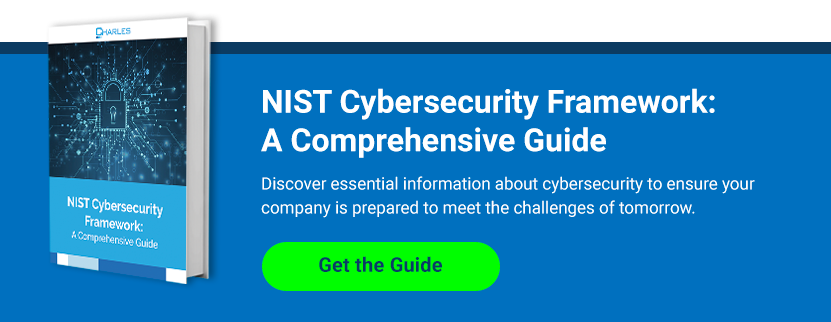
Given the rapidly evolving nature of the cyberthreat landscape, a cybersecurity program needs to be similarly dynamic and adaptable. An effective program continuously improves to tackle the latest threats and remain relevant.
Introduction to the NIST Cybersecurity Framework
The NIST Cybersecurity Framework (CSF) has evolved significantly since its last update in April 2023, refining its core structure to better address the complexities of modern cybersecurity threats. While the CSF is not a maturity model like the Cybersecurity Maturity Model Certification (CMMC) mandated across the defense industry, it provides essential guidance through six core functions and four tiers that organizations of all types can follow. These elements are designed to help businesses assess their cybersecurity capabilities, understand their current positioning, and enhance their overall security posture.An Overview | NIST Tiers and Levels
A common source of confusion when implementing the NIST CSF lies in the framework's dual reference to tiers and maturity levels. The tiers offer guidance on how organizations interact with and manage cybersecurity alongside operational risk, serving as a benchmark for evaluating existing practices against regulatory requirements and the organization’s risk appetite. In contrast, the maturity levels provide insight into an organization's progression in protecting its assets, identifying and detecting cyber threats, responding effectively to incidents, and recovering from disruptions. This framework empowers organizations to map their current state and plan for future enhancements in their cybersecurity strategy.

Using a NIST CSF Maturity Assessment Tool in Connecticut
Organizations should regularly assess their readiness to tackle new and emerging threats, as well
as old ones. This applies across all industries, albeit some more so than others. For example, defense contractors must work towards becoming compliant with the CMMC framework, while healthcare organizations are required to follow HIPAA regulations.Although the NIST Cybersecurity Framework should not be taken as a maturity model in itself, using a self-assessment tool can help you keep track of your security program and identify the areas in need of improvement.
Companies are encouraged to continuously improve their security maturity to the point that the approach becomes proactive enough to counter more advanced threats. In the case of NIST, this means aiming for the fourth tier:
NIST Tier 1 | Partial
At the lowest tier, cybersecurity risk management has not been formalized and documented. Instead, threats are countered on an ad-hoc basis, typically in a reactive manner. Companies at this tier face a significant degree of risk since there will also be limited awareness and a lack of advanced technical and administrative controls.
NIST Tier 2 | Risk-Informed
While there might not be an organization-wide policy on risk management, the second tier of the NIST CSF considers key stakeholders to be aware of the main risks. There will likely be a few controls and policies in place to protect digital assets, but management tends to address risks as they appear. In other words, it is primarily reactive in nature.
NIST Tier 3 | Repeatable
At the third tier, organizations have established repeatable processes to counter threats, and there is a formal risk-management process with a set of clearly defined security policies. This is the minimum level that most organizations will want to achieve since it provides a high degree of protection against new and emerging threats.
NIST Tier 4 | Adaptable
The fourth and final tier revolves around continuous improvement and adaptation. Companies that have reached this tier regularly conduct risk assessments and adapt security policies and procedures to counter the latest threats. It relies heavily on advanced analytics to provide a constant stream of insights and best practices.
Benchmark Your Current Security Posture
The successful implementation of the NIST Cybersecurity Framework requires organizations to evaluate their capabilities across three key areas – risk management processes, integrated risk management programs, and external participation. For example, at the lowest tier, the risk management process is entirely reactive and ad-hoc in nature. At the highest tier, its security practices are based on previous and current activities and incidents and are improving all the time.
The most effective way to benchmark your existing security posture is to get an outside view. This fresh perspective may well uncover issues you didn't know existed, which is especially important at a time when most threats come from outside. A suitable implementation of the NIST CSF revolves around determining the business impact of an incident, your appetite for risk, and the actual threat vectors facing your business.
Charles IT in Connecticut provides the full range of services that businesses need to become fully compliant with the NIST Cybersecurity Framework. Get in touch today to schedule your first consultation! Don't want to wait? Click here to schedule time directly with one of our team members!
Editor's Note: This post was originally published in October 2021 and has been updated for accuracy and comprehensiveness in 2024.
The NIST Cybersecurity Framework was updated in April 2023, expanding from five to six core functions. These updates enhance the framework's applicability across various industries, including those prevalent in Connecticut. Understanding these changes allows local businesses to better align their cybersecurity strategies with the latest best practices and regulatory expectations.





